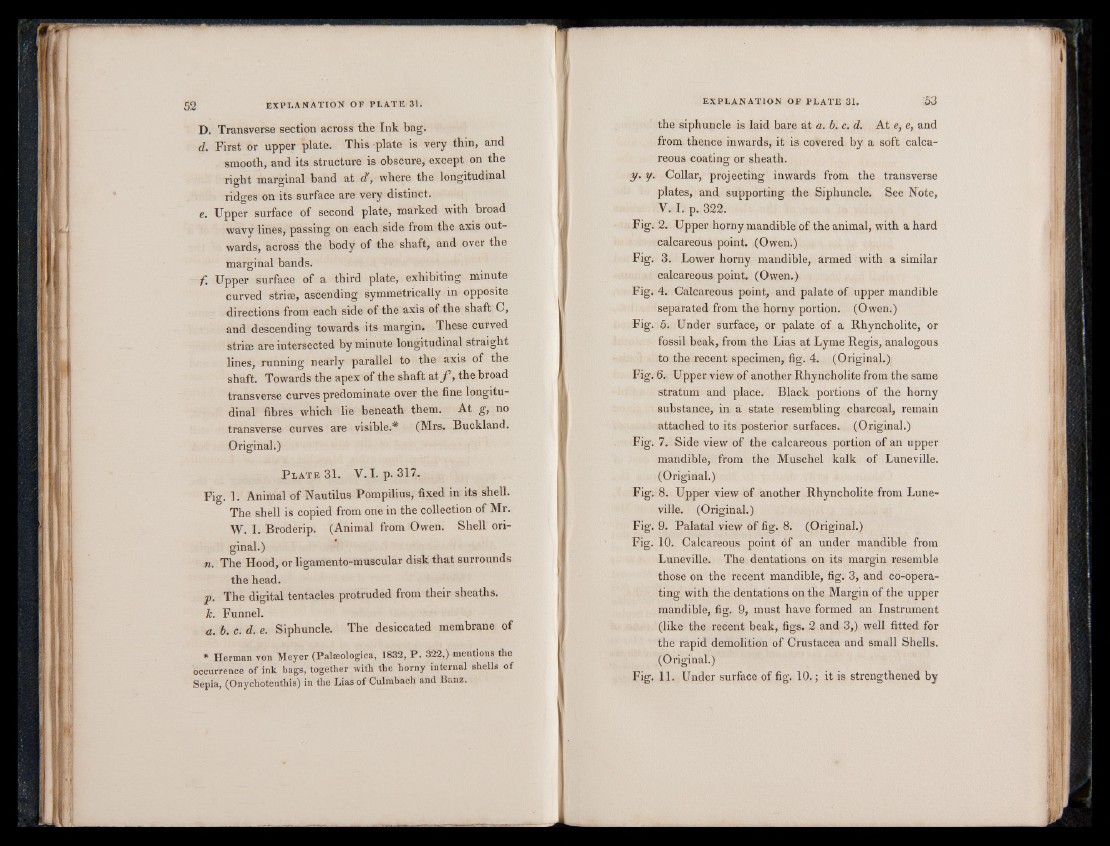
D. Transverse section across the Ink bag.
d. First or upper plate. This plate is very thin, and
smooth, and its structure is obscure, except on the
right marginal band at d!, where the longitudinal
ridges on its surface are very distinct.
e. Upper surface of second plate, marked with broad
wavy lines, passing on each side from the axis outwards,
across the body of the shaft, and over the
marginal bands.
f. Upper surface of a third plate, exhibiting minute
curved striae, ascending symmetrically in opposite
directions from each side of the axis of the shaft C,
and descending towards its margin. These curved
striae are intersected by minute longitudinal straight
lines, running nearly parallel to the axis of the
shaft. Towards the apex of the shaft at ƒ , the broad
transverse curves predominate over the fine longitudinal
fibres which lie beneath them. At g, no
transverse curves are visible.* (Mrs. Buckland.
Original.)
P late 31. V. I. p. 317.
Fig. 1. Animal of Nautilus Pompilius, fixed in its shell.
The shell is copied from one in the collection of Mr.
W. I. Broderip. (Animal from Owen. Shell original.)
n. The Hood, or ligamento-muscular disk that surrounds
the head.
p. The digital tentacles protruded from their sheaths.
k. Funnel.
a. b. c. d. e. Siphuncle. The desiccated membrane of
* Herman von Meyer (Palseologica, 1832, P . 322,) mentions the
occurrence of ink bags, together with the horny internal shells of
Sepia, (Onychoteuthis) in the Lias of Culmbach and Banz.
the siphuncle is laid bare at a. b. c. d. At e, e, and
from thence inwards, it is covered by a soft calcareous
coating or sheath.
y . y. Collar, projecting inwards from the transverse
plates, and supporting the Siphuncle. See Note,
V. I. p. 322.
Fig. 2. Upper horny mandible of the animal, with a hard
calcareous point. (Owen.)
Fig. 3. Lower horny mandible, armed with a similar
calcareous point. (Owen.)
Fig. 4. Calcareous point, and palate of upper mandible
separated from the horny portion. (Owen.)
Fig. 5. Under surface, or palate of a Rhyncholite, or
fossil beak, from the Lias at Lyme Regis, analogous
to the recent specimen, fig. 4. (Original.)
Fig. 6- Upper view of another Rhyncholite from the same
stratum and place. Black portions of the horny
substance, in a state resembling charcoal, remain
attached to its posterior surfaces. (Original.)
Fig. 7. Side view of the calcareous portion of an upper
mandible, from the Muschel kalk of Luneville.
(Original.)
Fig. 8. Upper view of another Rhyncholite from Luneville.
(Original.)
Fig. 9. Palatal view of fig. 8. (Original.)
Fig. 10. Calcareous point of an under mandible from
Luneville. The dentations on its margin resemble
those on the recent mandible, fig. 3, and co-operating
with the dentations on the Margin of the upper
mandible, fig. 9, must have formed an Instrument
(like the recent beak, figs. 2 and 3,) well fitted for
the rapid demolition of Crustacea and small Shells.
(Original.)
Fig. 11. Under surface of fig. 10.; it is strengthened by